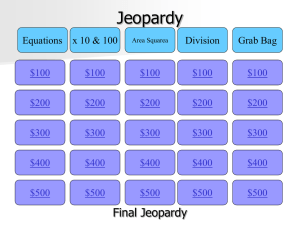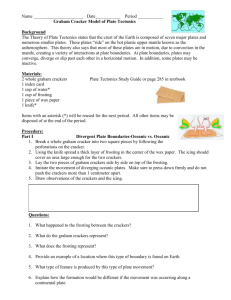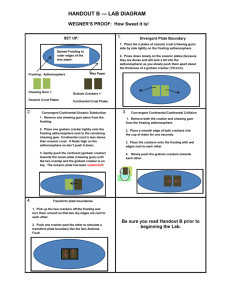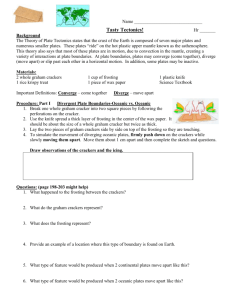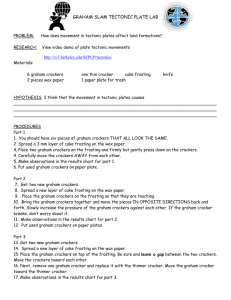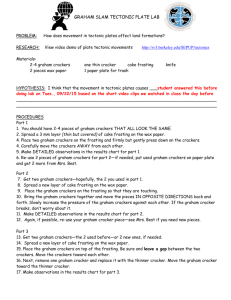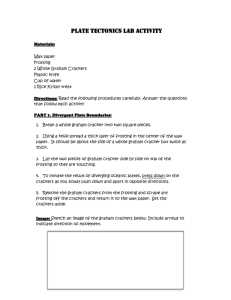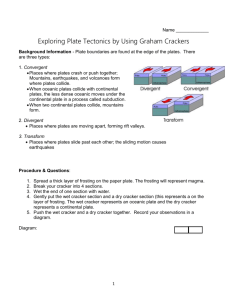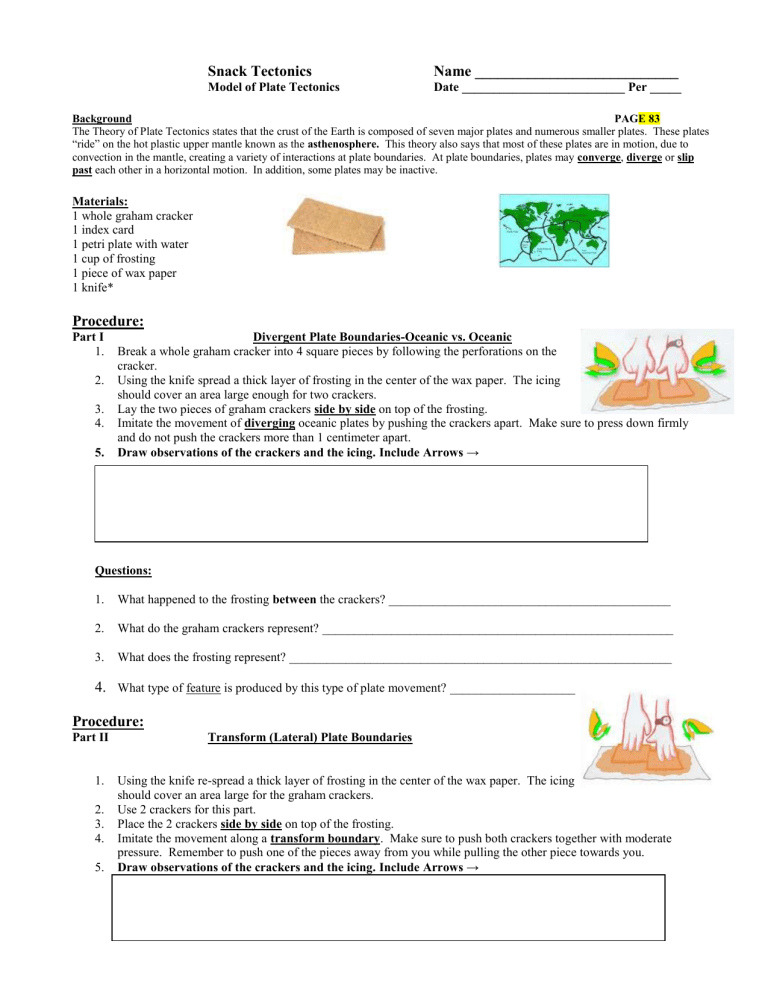
Snack Tectonics Name ___________________________ Model of Plate Tectonics Date __________________________ Per _____ Background PAGE 83 The Theory of Plate Tectonics states that the crust of the Earth is composed of seven major plates and numerous smaller plates. These plates “ride” on the hot plastic upper mantle known as the asthenosphere. This theory also says that most of these plates are in motion, due to convection in the mantle, creating a variety of interactions at plate boundaries. At plate boundaries, plates may converge, diverge or slip past each other in a horizontal motion. In addition, some plates may be inactive. Materials: 1 whole graham cracker 1 index card 1 petri plate with water 1 cup of frosting 1 piece of wax paper 1 knife* Procedure: Part I 1. 2. 3. 4. 5. Divergent Plate Boundaries-Oceanic vs. Oceanic Break a whole graham cracker into 4 square pieces by following the perforations on the cracker. Using the knife spread a thick layer of frosting in the center of the wax paper. The icing should cover an area large enough for two crackers. Lay the two pieces of graham crackers side by side on top of the frosting. Imitate the movement of diverging oceanic plates by pushing the crackers apart. Make sure to press down firmly and do not push the crackers more than 1 centimeter apart. Draw observations of the crackers and the icing. Include Arrows → Questions: 1. What happened to the frosting between the crackers? _____________________________________________ 2. What do the graham crackers represent? ________________________________________________________ 3. What does the frosting represent? _____________________________________________________________ 4. What type of feature is produced by this type of plate movement? ____________________ Procedure: Part II 1. 2. 3. 4. 5. Transform (Lateral) Plate Boundaries Using the knife re-spread a thick layer of frosting in the center of the wax paper. The icing should cover an area large for the graham crackers. Use 2 crackers for this part. Place the 2 crackers side by side on top of the frosting. Imitate the movement along a transform boundary. Make sure to push both crackers together with moderate pressure. Remember to push one of the pieces away from you while pulling the other piece towards you. Draw observations of the crackers and the icing. Include Arrows → Part II Questions: Transform Boundary (continued) 1. Provide an example of a location where this type of boundary is found on Earth. ________________________ 2. Nothing happens to the crackers in the beginning, but as the pressure is increased, the crackers finally break. Explain how this is similar to the situation along the San Andreas Fault. ________________________________________________________________ Part III Convergent Plate Boundaries-Oceanic vs. Continental 1. Using the knife re-spread a thick layer of frosting in the center of the wax paper. The icing should cover an area large enough for a graham cracker and an index card placed end to end. The graham cracker represents the less dense continental lithosphere. The index card represents the more dense oceanic lithosphere. 2. Lay an entire graham cracker and an index card end to end on top of the icing. 3. Imitate the movement of a converging oceanic plate with a continental plate. Make sure to press down lightly. This movement might have to be forced a bit. 4. Draw observations of the crackers and the icing. Include Arrows → Questions: 1. Explain why the graham cracker and index card represent the type of crust they do. 2. What happens when the graham cracker and index card meet; which one goes under? _______________________ 3. What happens when a piece of Earth’s crust is subducted? ____________________________________________ 4. What features are formed along the subduction zone? ________________________________________________ Procedure: Part IV 1. 2. 3. 4. 5. Converging Plate Boundaries-Continental vs. Continental Using the knife re-spread a thick layer of frosting in the center of the wax paper. The icing should cover an area large enough for the graham crackers. Re-use 2 pieces of the graham cracker from part II. Each piece of the graham cracker will represent a continental plate. Dip one end (approximately 2 centimeters) of each of the graham crackers into the cup of WATER. Immediately remove the crackers from the water and lay them end to end on top of the icing. THEY SHOULD NOT BE SOGGY! Imitate the movement of a converging continental with a continental plate. Make sure to press lightly. Draw observations of the crackers and the icing. Include Arrows → Questions: 1. Explain what happens to the wet ends of the graham crackers. _________________________________ 2. What feature do the ends of the wet graham crackers represent? ________________________________ 3. Provide an example of a location where this type of boundary is found on Earth? __________________
